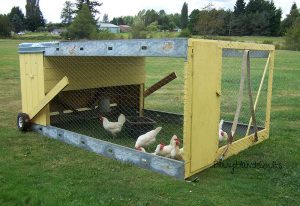Author: Brian Barth
The epitome of a low-tech agriculture solution, these coops on wheels give your birds constant access to fresh food, while fertilizing the soil and controlling pests.

The idea is you move a chicken tractor across your pasture (or backyard) every day, or every few days, so your flock constantly has fresh vegetation to forage in. Chickens like to eat the tender tips of grass and weeds, and they especially relish bugs, slugs, and snails – which helps make a dent in the pest population on your property. As you move the tractor around, they leave their nitrogen- and phosphorus-rich manure behind them.
It’s called a chicken “tractor” because the scratching action of the birds quickly denudes the ground and loosens the top inch or so of earth. It’s one way to get rid of a lawn or a weed patch in preparation for planting a garden. But if you just want the birds to perform pest control and fertilize your lawn or pasture without turning it into a dirt patch, make sure to move the tractor on a daily basis so they don’t work any one area down to bare earth.
The internet is chock-full of chicken tractor plans, with designs that range from ramshackle contraptions cobbled together with used pallets to models that repurpose old cars to sleek, modernist egg-mobiles. Larger models for commercial operations are likely to make use of a mobile home, salvaged school bus, or equipment trailer. You can also purchase a prefab chicken tractor, like these from Smoky Mountain Chicken Tractors that start at $350, or this rustic-luxe model from Williams-Sonoma that’ll set you back more than $2,000.
But all chicken tractors are comprised of a few basic components: an enclosed nesting area, a chicken “run” covered with wire mesh to exclude predators, and a frame with wheels so you can pull it around. If you choose to build your own – like these that we found on Instagram – how well you pull it off will depend on the materials you have on hand to work with (or your budget to buy them with) and your engineering (or at least, MacGyvering) skills. Of course a little creativity in the design doesn’t hurt.

3 Comments. Leave new
Thank you for taking the time.
Best regards,
Harrell Griffin
Great and an informative article!
Best regards,
Thomassen Valenzuela
Thank you Thomassen for visiting our website. Kindest regards.